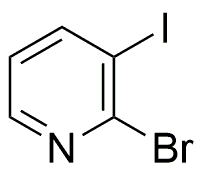2-Bromo-3-iodopyridine is widely utilized in research focused on:
- Synthesis of Pharmaceuticals: This compound serves as an important intermediate in the synthesis of various pharmaceutical agents, particularly those targeting neurological disorders.
- Development of Agrochemicals: It is used in the formulation of agrochemicals, enhancing the efficacy of crop protection products by acting as a building block for more complex molecules.
- Material Science: The compound is employed in the development of new materials, particularly in organic electronics, due to its unique electronic properties.
- Research in Medicinal Chemistry: Researchers utilize it to explore new drug candidates, especially in the study of receptor interactions and enzyme inhibition.
- Fluorescent Probes: It can be modified to create fluorescent probes for biological imaging, aiding in the visualization of cellular processes.
Informations générales
Propriétés
Sécurité et réglementation
Applications
2-Bromo-3-iodopyridine is widely utilized in research focused on:
- Synthesis of Pharmaceuticals: This compound serves as an important intermediate in the synthesis of various pharmaceutical agents, particularly those targeting neurological disorders.
- Development of Agrochemicals: It is used in the formulation of agrochemicals, enhancing the efficacy of crop protection products by acting as a building block for more complex molecules.
- Material Science: The compound is employed in the development of new materials, particularly in organic electronics, due to its unique electronic properties.
- Research in Medicinal Chemistry: Researchers utilize it to explore new drug candidates, especially in the study of receptor interactions and enzyme inhibition.
- Fluorescent Probes: It can be modified to create fluorescent probes for biological imaging, aiding in the visualization of cellular processes.
Documents
Fiches de données de sécurité (FDS)
La FDS fournit des informations de sécurité complètes sur la manipulation, le stockage et l’élimination du produit.
Spécifications du produit (PS)
Le PS fournit une description complète des propriétés du produit, notamment sa composition chimique, son état physique, sa pureté et les exigences de stockage. Il détaille également les plages de qualité acceptables et les applications prévues du produit.
Certificats d'analyse (COA)
Recherchez des certificats d'analyse (COA) en saisissant le numéro de lot du produit. Les numéros de lot et de lot se trouvent sur l'étiquette d'un produit, après les mots « Lot » ou « Lot de fabrication ».
Numéro de catalogue
Numéro de lot/série
Certificats d'origine (COO)
Ce certificat d'exploitation confirme le pays dans lequel le produit a été fabriqué, et détaille également les matériaux et composants utilisés et s'il est issu de sources naturelles, synthétiques ou autres sources spécifiques. Ce certificat peut être requis pour les douanes, le commerce et la conformité réglementaire.
Numéro de catalogue
Numéro de lot/série
Fiches de données de sécurité (FDS)
La FDS fournit des informations de sécurité complètes sur la manipulation, le stockage et l’élimination du produit.
DownloadSpécifications du produit (PS)
Le PS fournit une description complète des propriétés du produit, notamment sa composition chimique, son état physique, sa pureté et les exigences de stockage. Il détaille également les plages de qualité acceptables et les applications prévues du produit.
DownloadCertificats d'analyse (COA)
Recherchez des certificats d'analyse (COA) en saisissant le numéro de lot du produit. Les numéros de lot et de lot se trouvent sur l'étiquette d'un produit, après les mots « Lot » ou « Lot de fabrication ».
Numéro de catalogue
Numéro de lot/série
Certificats d'origine (COO)
Ce certificat d'exploitation confirme le pays dans lequel le produit a été fabriqué, et détaille également les matériaux et composants utilisés et s'il est issu de sources naturelles, synthétiques ou autres sources spécifiques. Ce certificat peut être requis pour les douanes, le commerce et la conformité réglementaire.


